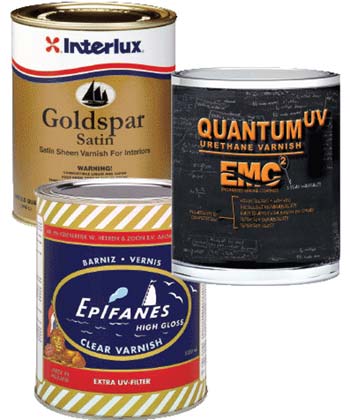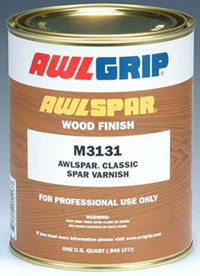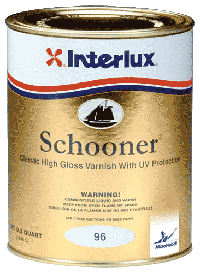Advertisement
Don't know a resin from a polyurethane? Read on to learn how to decipher that can.

This small boat is finished with Awlwood giving a crystal clear surface that shows off hte wood grain.
There are lots of different makes of varnish available, and you'd think that you could just walk into your nearest store and pick almost any can, right? Not so fast! There's more to choosing the right varnish than it might appear — choose the wrong sort and you could be left with an expensive mess.
Basically, there are three kinds of varnish: Oil based, usually made with tung oil as one of the main ingredients; polyurethanes, which generally have a synthetic-oil base; and two-part varnishes, which, as the name implies, is a resin base to which a hardener, or catalyst is added prior to application. Unless you're starting off from bare wood, the most sensible way is to use the same finish that was applied last time. The varnish will be compatible with what's on the boat already, and the color will be consistent. When varnishing bare wood, almost any varnish can be used, but read the instructions on the can carefully before starting.
Tung-Oil Varnishes

Choosing the correct varnish can make all the difference
when it comes to the final result.
Old-time varnishes were boiled down from tree resin. Older-style varnishes tend to be thicker and may be made from a combination of tung oil, phenolic resins, and alkyds. Most of these varnishes were developed for furniture and only later used for boat masts. Given that a mast flexes in the wind, the varnish needs to move with it rather than crack. This gave rise to single-part, tung-oil-based varnish often referred to as "spar" varnish. With these, the varnish is dissolved in solvents, so it begins to harden as soon as it's applied. You can apply a second coat of tung-oil varnish before the first layer is totally hardened because the solvents will keep evaporating out of the underlying varnish layer. Jim Seidel, who retired as marketing manager of Interlux, says, "You need to be careful when applying tung-oil varnish on horizontal surfaces as you can lay it on too heavily and it feels dry, but depending on the thickness of the coating and temperature you're working in, it may trap solvent and can lead to alligatoring." These varnishes tend to give a slight yellow cast to the wood.
Polyurethanes
Oil-based one-part polyurethanes are made using chemicals similar to epoxy and can be used to cover clear epoxy resin. In fact, one way to build up layers fast is to coat the wood with epoxy and finish with three or four coats of high-UV polyurethane. Polyurethanes can be oil- or water-based. Oil-based polyurethanes tend to be harder, and last slightly longer, but they can also crack. When applying oil-based polyurethanes, you need to let one layer harden completely, then sand it lightly, before applying a second coat. Oil-based polyurethanes tend to give a slight yellow color to the wood.
Water-based polyurethanes are easier to clean up, but they're slightly softer and don't last quite as long as oil-based. Again the varnish needs to harden before applying a second coat. Water-based varnishes can be almost totally clear.
Two-Part Varnishes
Two-part varnishes need to be mixed before they're used. In most cases, the base and the hardener are in separate cans, and you simply pour the contents of one can into the other and stir well. The advantage of two-part polyurethane varnishes is that they last longer and are far more abrasion resistant. It is important to note that due to the very hard nature of the coating, a two-part varnish can't be applied over a one-part varnish, as they're incompatible with each other. The problem with two-part varnishes is that they only have several hours in which they stay liquid. (The "pot life" that the varnish stays useable can be from several hours up to two days.) Once the varnish is spread out on the job, it will begin to harden as air and moisture in the air act on it. These varnishes tend to be clear and need to be thoroughly dry before a second coat is applied. Steve Schultz, formerly with Interlux and now with EMC Quantum, says, "Two-part varnishes are a better choice because they last longer and reduce the labor required. In turn, this reduces the overall cost of varnish maintenance."
Two-part varnishes contain isocyanates, and while many are meant to be applied by a professional (with safety precautions) they can be brushed on provided the user wears a respirator. Isocyanates become a problem when they're sprayed because the fine particle size can affect the user's lungs. Brushing them, provided the user observes standard safety precautions (gloves, eye protection, and respirator), is preferable.
Commonly Available Varnishes
Single-Part Varnishes And Coatings
Awlgrip AwlSpar (for professional use only)
Bristol Finish Traditional Amber Urethane (exterior), Classic Clear Water Based Urethane (Interior only)
Detco Crystal Varnish (clear coat)
Epifanes Clear Varnish (Tung oil/Alkyd/max UV resistant), Rapid Coat (Alkyd/Urethane), Woodfinish (tung oil/urethane)
HMG Marine Coma Berenice (polyurethane/Alkyd)
Interlux Compass Clear (polyurethane), Schooner Gold (high build, high performance), Schooner (polyurethane), Goldspar Satin (modified polyurethane)
Le Tonkinois (Tung oil/linseed oil)
Minwax Helmsman Spar Urethane, Water based Spar Urethane
Pettit Z Spar (linseed/Tung oil), Z Spar Flagship (linseed/Tung oil), Captain's Varnish (alkyd/phenolic/Tung/Linseed oil), Hi build (tung oil/phenolic/linseed oil), EasyPoxy (urethane)
PermaJet PermaPROtect GLO, SAT (water based polymer)
Signature Finish Clear Urethane
West Marine Brand Admiral's Varnish (alkyd), Five Star Premium (alkyd), WoodShield (synthetic wood finish)
Two-Part Varnishes
Awlgrip AwlBrite Clear (for professional use only)
Alexseal Clear (for professional use only)
EMC Quantum UV Varnish
Interlux Perfection Plus (Clear polyurethane)
Signature Finish Honey Teak (Urethane Enamel top coat)
Pigmented Oil-Based Coatings
Owatrol Marine Deks Ole
Minwax Teak Oil




